The 1980s marked a seismic shift in the motorcycle industry, particularly within the exhilarating realm of dirt bikes. Two-stroke engines had decisively seized dominance, ushering in an era of raw power and lightweight machines. This period witnessed the birth of legendary big bore 2-stroke dirt bikes, machines that not only defined a decade but also paved the way for the sophisticated dirt bikes we admire today. These weren’t just motorcycles; they were statements – audacious, powerful, and brimming with character. Their appeal lay in a potent combination: high power output, remarkably low weight, and mechanical simplicity, a heady mix that continues to captivate enthusiasts. While contemporary bikes boast advanced technology, these vintage beasts compensated with sheer force and an untamed spirit, rightfully earning their place in the pantheon of motorcycle history.
Let’s embark on a journey back to this golden age, exploring the most celebrated 500cc Dirt Bikes of the 1980s. We’ll start with the universally recognized icons and gradually delve into some of the lesser-known gems that equally deserve acknowledgment.
Honda CR500R: The King of Big Bore Two-Strokes
When discussing 500cc two-stroke dirt bike royalty, the Honda CR500R inevitably claims the throne. Born from the collaborative genius of Soichiro Honda and the Honda R&D Americas team – the very minds behind the Elsinore – the CR500R was a fire-breathing marvel. This machine was engineered to unleash seemingly limitless power. While horsepower figures are debated, with some claiming 60HP, a consensus points towards a formidable 55HP at the rear wheel. The 1985 CR500R, in particular, churned out over 65Nm of torque, cementing its status as an icon among big bore 2-stroke dirt bikes.

Produced for an impressive 16 years until its discontinuation around 2001, the CR500R’s legacy endures. Even today, demand would surge if Honda were to revive its production. Throughout its run, iterative updates refined the bike, enhancing its performance and handling. While later models boasted improvements, every CR500R demands respect. These bikes, especially the earlier iterations, were not for the faint of heart. Mastering a CR500R required skill and deference; disrespect could lead to a swift and unforgiving lesson. The final CR500R models represent the zenith of big bore 2-stroke development, a testament to continuous refinement, and a machine that commands both admiration and caution.
Yamaha YZ490: The Rider-Friendly Powerhouse
Yamaha’s contender in the 500cc arena, the Yamaha YZ490, was renowned for its raw speed. While it might not have eclipsed the Honda in sheer horsepower, the YZ490 excelled at translating power into traction. Yamaha prioritized rider accessibility, engineering a bike with a more manageable power delivery, lower in the rev range, and smoother than the CR500R’s aggressive surge.
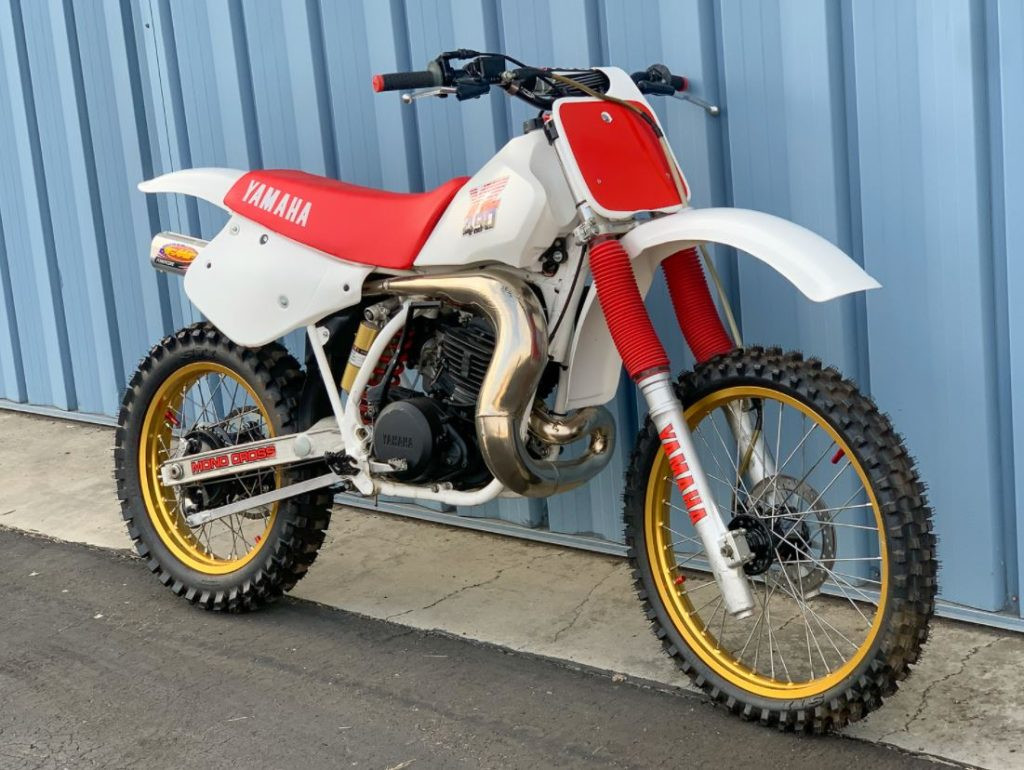
Yamaha’s advancements in suspension technology, particularly their Monoshock system with adjustable compression damping, gave the YZ490 a significant edge in handling. This made it a favorite across rider skill levels, not solely reserved for professional racers. Producing around 50HP at the rear wheel, coupled with nearly 50Nm of torque at under 6,000rpm, the YZ490 delivered a substantial kick. Its engine design prioritized industrial simplicity, a reed valve engine devoid of water cooling, resonance chambers, or exhaust valves. This kept production costs down and contributed to its robust reliability, allowing the engine to remain largely unchanged for years.
Initially met with skepticism by Yamaha loyalists as a replacement for the YZ465, the YZ490 evolved into one of the most beloved dirt bikes of all time. Today, well-preserved YZ490s are highly sought-after collectibles, their value appreciating annually. Finding one in good condition is becoming increasingly challenging, adding to their allure for vintage motorcycle enthusiasts.
Kawasaki KX500: The Unrivaled Power King
The Kawasaki KX500 entered the scene with a reputation for untamed ferocity, initially labeled as “violent” and “unrideable.” However, this brute force translated into unmatched performance. Producing almost 65HP in its standard configuration, the KX500 reigned supreme as the most potent of the Japanese big bore 2-strokes. Its astonishing power-to-weight ratio, achieved with a weight of just 105Kg (230lbs), further amplified its dominance.
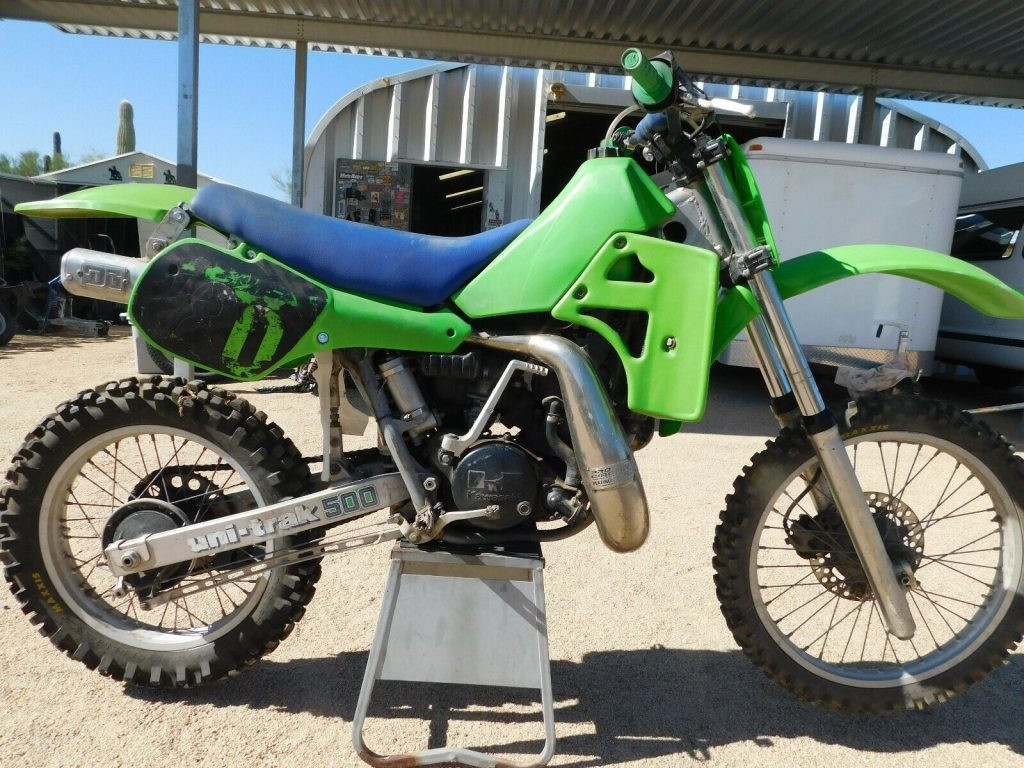
Despite the rapid evolution of motocross technology, the Kawasaki KX500 maintained its competitive edge for nearly a decade. Kawasaki’s commitment to cost-effectiveness made the KX500 a winner both on the track and in showrooms. Its production spanned over two decades, setting the benchmark against which all subsequent big bore dirt bikes were measured. The KX500’s robust and rigid chassis complemented its powerful engine, ensuring exceptional handling. Kawasaki’s relentless pursuit of weight reduction and power augmentation in every component solidified their reputation for building formidable engines. Even today, the Kawasaki KX500 retains its legendary status, hailed by many as the undisputed king of big bore dirt bikes.
Suzuki RM500: The Underachiever with Potential
Positioned between Suzuki’s factory-spec RN500 motocrosser and the versatile TM400, the Suzuki RM500 held considerable promise. Yet, it never quite achieved the resounding success anticipated. Despite Suzuki’s efforts, the RM500 seemed perpetually unable to hit the mark, often criticized for its somewhat dated design approach.
Its slower steering and a flatter, less explosive power delivery made it more manageable to ride compared to its rivals. However, this tamed performance meant it often lagged behind off the starting gate when competing against the Honda, Yamaha, and Kawasaki. While undeniably a competent bike, it simply lacked the competitive edge needed to truly excel in the fiercely contested 500cc class. In contrast to the Yamaha YZ490, which consistently exceeded expectations, the Suzuki RM500 often felt like it fell short of its potential. Despite its shortcomings, its place in the history of 500cc dirt bikes warrants recognition.
Maico GP500E: The European Challenger
Venturing beyond the Japanese giants, we encounter two contenders from the esteemed Maico factory: the Maico GP500E and the Enduro variant. Maico had cultivated a formidable reputation for producing the most potent air-cooled 2-stroke engines. The GP500E, however, represented a bold step into water-cooled technology, aimed at reclaiming the title of the most powerful dirt bike from Kawasaki.
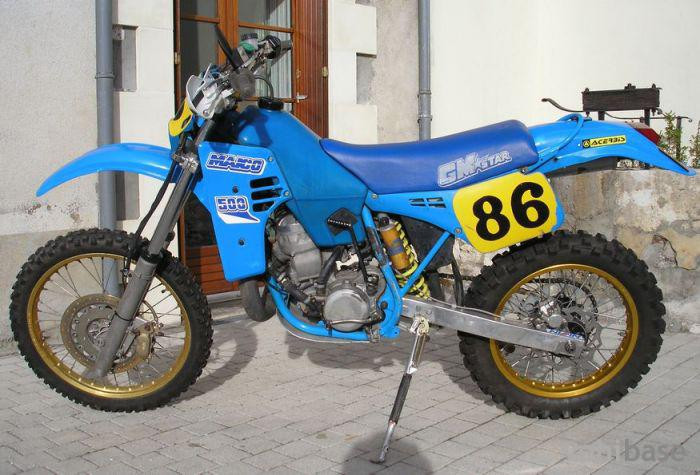
This machine was a true beast, boasting a high 13.5:1 compression ratio, yet remarkably maintaining engine strength and reliability. However, Maico’s long-standing financial difficulties cast a shadow over this ambitious project, making the GP500E a final gamble for the original company. Ultimately, in its stock form, the GP500E narrowly missed surpassing the Kawasaki in outright power, making its premium price tag a deterrent for many buyers. Despite being a superb machine, financial realities led to the inevitable bankruptcy of the original Maico company. The Maico name perseveres, with bikes still produced in limited numbers today. Intriguingly, the GP500E engine lineage extends to the Zabel 700cc engines, which have achieved considerable success in sidecar-cross racing. The demise of Maico serves as a poignant reminder of the fragility of even the most respected brands in the face of economic pressures and the relentless pace of development by larger manufacturers.
Husqvarna 500XC: The Agile Swede
In 1975, Husqvarna signaled its arrival as a serious contender with the 460WR. Eight years later, in late 1983, the Swedish marque unleashed the all-new Husqvarna 500XC and 500WR models. Featuring advancements like 4 transfer ports and a bridged inlet port system, power output was significantly elevated. An innovative 8-petal reed valve on the induction ports enhanced both power and efficiency.

The 500XC produced comparable power to the Yamaha YZ490 but delivered it across an even broader powerband. Equally adept at low-speed crawling and explosive acceleration, the Husky excelled in diverse terrains. Its agile and predictable handling made it a joy to ride, marking a substantial leap forward for Husqvarna. While it would take until 1993 for Jacky Martens to secure a world championship title for Husqvarna, the 500XC laid the foundation for their future success. However, converting racing victories into financial stability remained a persistent challenge for the Swedish manufacturer. Another European competitor, KTM, was also on the rise, introducing their own potent 500cc machine in 1985.
KTM 500MTX: The Smooth Torque Master
The KTM 500MTX (or 500MCX as referred to in the original text, likely a minor error) emerged as a distinct offering in the 500cc class. While KTM had established its prowess in smaller capacity classes, conquering the premier class remained elusive. The new water-cooled engine in the 500MTX prioritized smooth power delivery and lightweight design over outright horsepower, a departure from KTM’s typical approach.
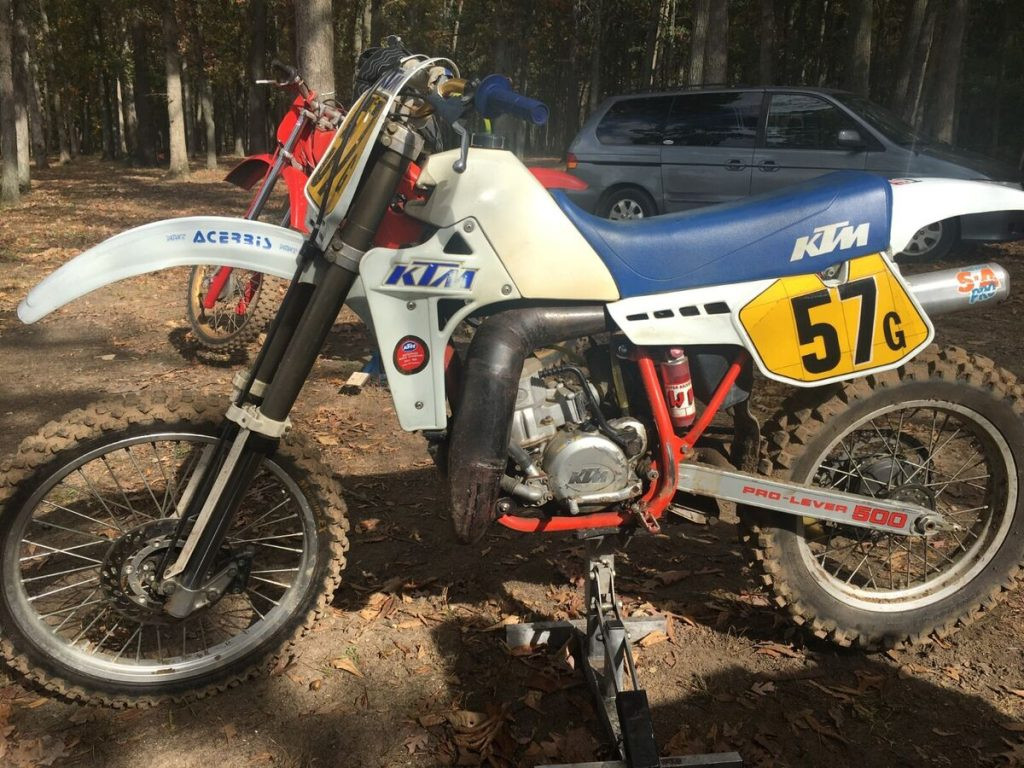
An increased stroke length reduced vibration to levels unmatched even by the refined Yamaha and Honda engines. This refinement allowed for a lighter engine and consequently, a lighter frame. Throttle response from idle to 4,000 rpm was exceptional, making short shifting the optimal riding technique to harness the engine’s torque. While the KTM 500MTX might not have possessed the raw, untamed power of the Kawasaki or Honda, its low-end torque and smooth delivery made it incredibly rider-friendly and effective in various conditions. While Honda dominated European motocross in the 1980s, and even the powerful Kawasakis couldn’t unseat them, by 1990, KTM was rapidly closing the gap. The 500MTX marked KTM’s ascent towards the top tier of premier class competition, offering a uniquely enjoyable riding experience.
Cagiva WMX500: The Italian Dream
The Castiglioni brothers in Varese, Italy, fueled by ambition, aimed to conquer the premier class. Having achieved success with Cagiva’s 125cc and 250cc engines, their sights were set on the 500cc crown. In a strategic move, Cagiva acquired Husqvarna on April 1, 1986 (a deal that was indeed no April Fool’s joke), taking full control just three months later. The result was the Cagiva WMX and MXR 500s.
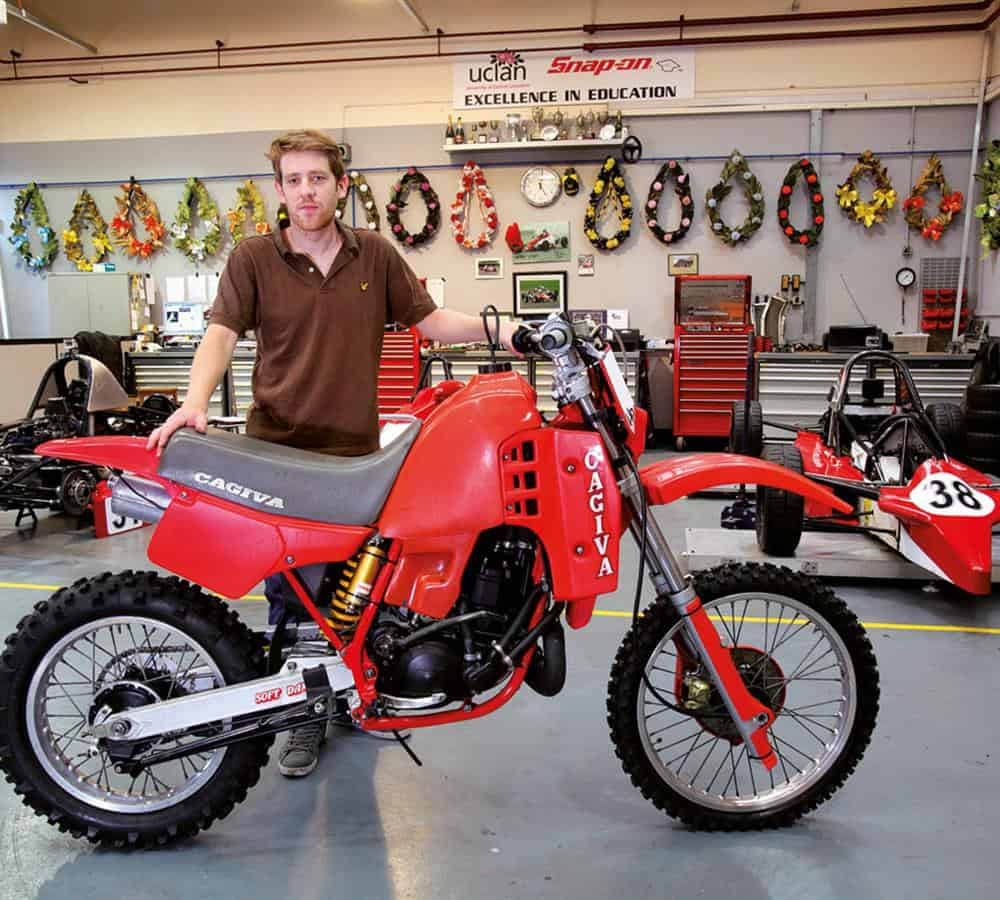
These bikes evoked mixed reactions. While undeniably fast and equipped with a capable chassis, the overall package never quite coalesced as intended. The demanding nature of the Castiglioni brothers sometimes created friction within the acquired companies. Cagiva itself never achieved direct success in the 500cc class. However, their investment in Husqvarna proved pivotal, contributing to the advancements that ultimately led to Husqvarna’s championship victory in 1993. The Cagiva MXR500 represents a blend of ambition and unrealized potential. While perhaps not as refined or mass-produced as its Japanese counterparts, finding a WMX500 with its initial issues resolved can reveal a unique and rewarding riding experience, deserving of its place among these legendary machines.
Honorary Mentions: Beyond the Main Contenders
While the spotlight shines on the aforementioned titans, several other bikes deserve recognition in the narrative of 500cc dirt bike history. The Suzuki TM400, despite its initial reputation for challenging handling, evolved into a favorite for many riders. Its inherent speed and subsequent refinements transformed it into a highly capable machine. Though not a 500cc, its significance in Suzuki’s history and its impact on the development of later models like the RM500 warrants acknowledgment.
Furthermore, while this article primarily celebrates 2-stroke legends, acknowledging the emerging 4-stroke technology of the era is crucial for a complete picture. The Suzuki DR500, a precursor to the DR650, offered a potent combination of DR350’s versatility and DR650’s torque, excelling in challenging terrain. The Honda XR500RE marked a pivotal moment as the first Japanese 4-stroke to seriously challenge the 2-stroke dominance, arguably paving the way for the 4-stroke revolution in motocross. Lastly, the Gilera Dakota, though not a racer, stood out as a powerful 4-stroke thumper of its time. Designed by Lucio Masut, its advanced water-cooled, twin-cam, 4-valve engine laid the groundwork for the larger engines used in successful Dakar Rally bikes and adventure models, foreshadowing the adventure bike boom of later years.
Conclusion: The Enduring Legacy of 500cc Dirt Bikes
The 500cc dirt bikes of the 1980s were more than just motorcycles; they were cultural icons, symbols of a thrilling era in off-road riding. From the brutal power of the Honda CR500R and Kawasaki KX500 to the rider-friendly Yamaha YZ490 and the agile Husqvarna 500XC, each bike offered a unique flavor of performance and character. Even machines like the Suzuki RM500 and Cagiva WMX500, despite their imperfections, contribute to the rich tapestry of this era. These roaring legends cemented the 500cc 2-stroke dirt bike as a force to be reckoned with, influencing generations of riders and shaping the future of off-road motorcycling. Their legacy continues to resonate, reminding us of a time when raw power and rider skill were paramount on the dirt track.
